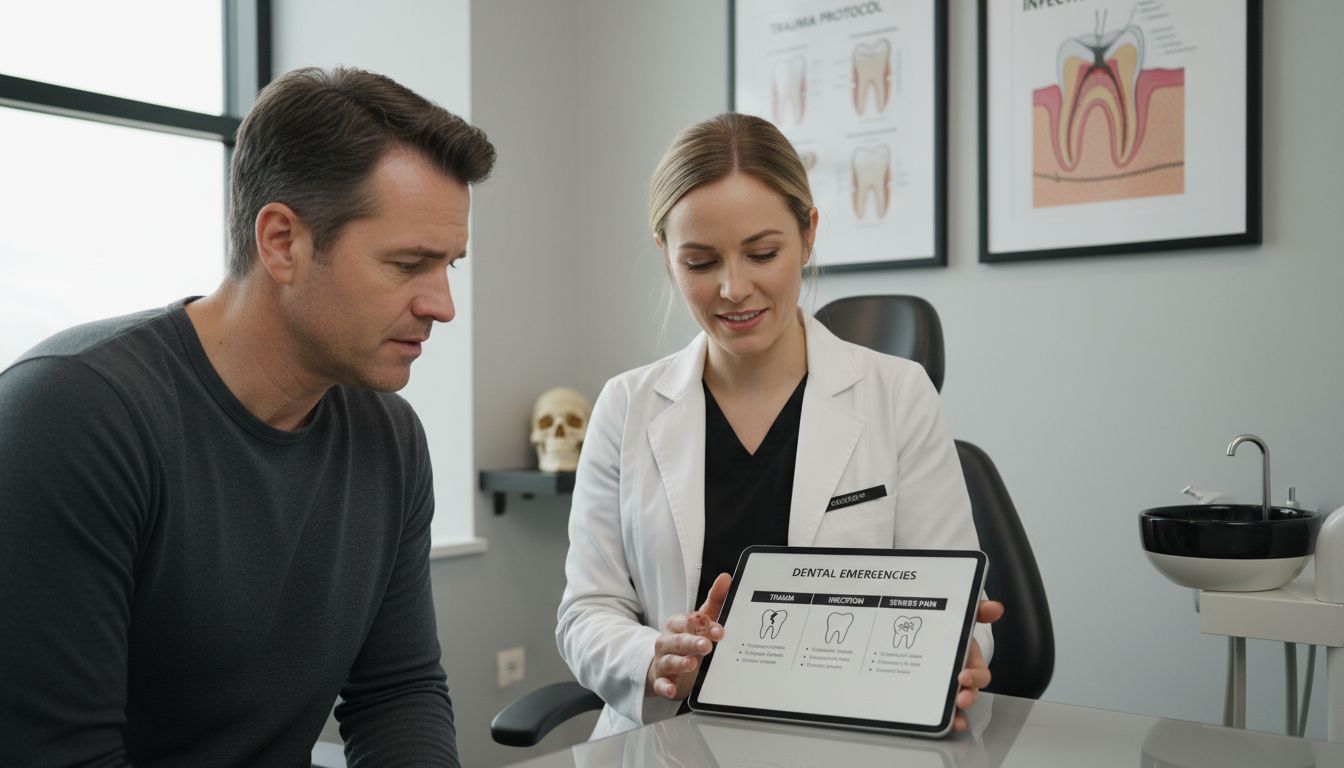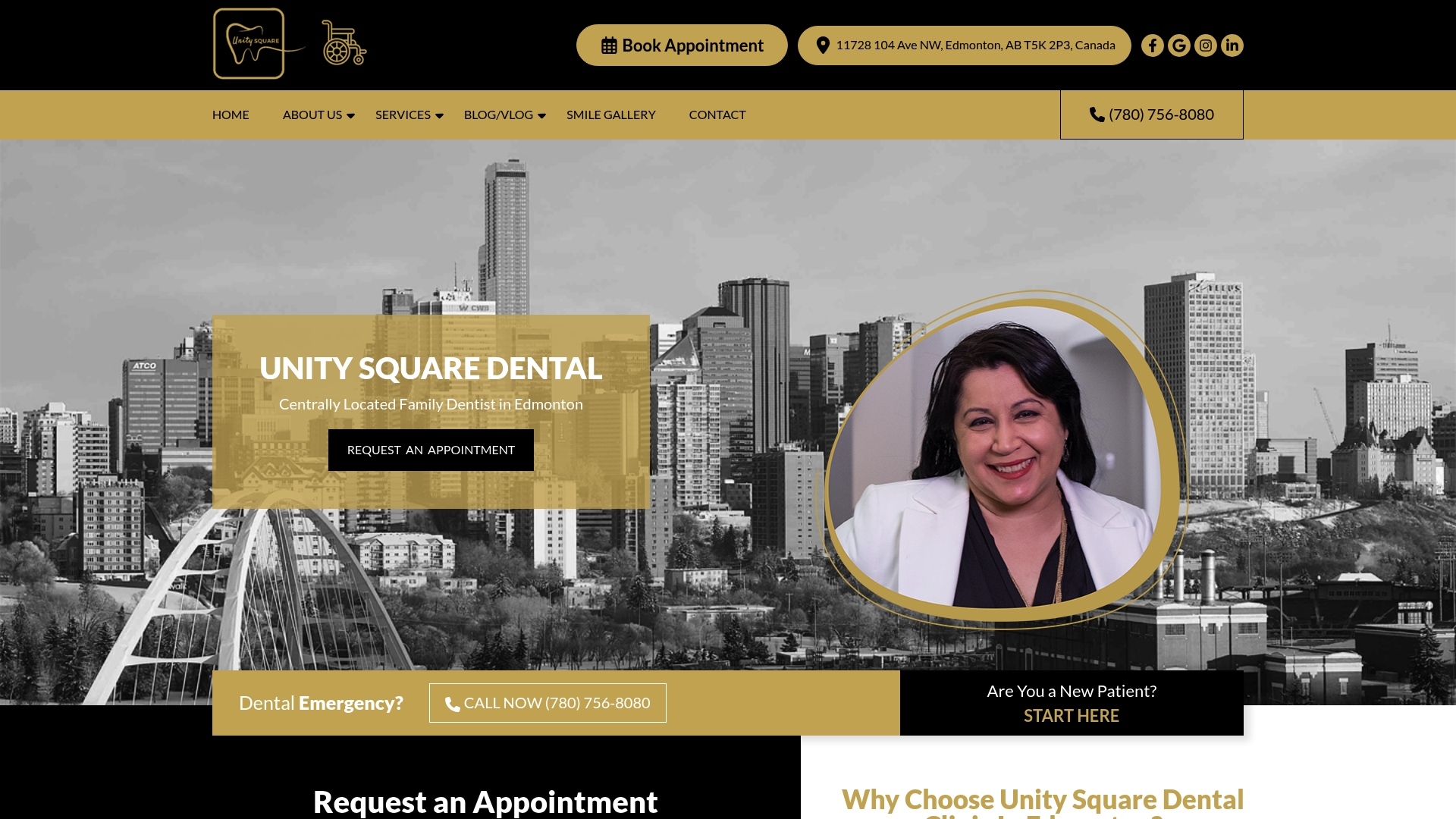
Severe tooth pain in the middle of the night or sudden swelling that makes it hard to breathe can strike without warning. Dental emergencies affect millions of people each year and can quickly turn a manageable problem into a crisis if not recognized in time. Knowing what truly counts as a dental emergency gives you the power to protect your health, avoid unnecessary stress, and respond with confidence when minutes matter.
Table of Contents
- Defining A Dental Emergency Properly
- Recognizing Categories Of Dental Emergencies
- Identifying Specific Emergency Scenarios
- Understanding Immediate Response Requirements
- Assessing Risks And Potential Complications
Key Takeaways
| Type of Emergency | Description |
|---|---|
| Critical Signs | Recognize severe bleeding, extreme pain, or significant swelling as indicators of a dental emergency that demands immediate care. |
| Categories of Emergencies | Understand the main categories: traumatic injuries, infection-related issues, and pain-related emergencies for effective identification and response. |
| Immediate Response | Implement swift assessment and stabilization protocols, including bleeding control and pain management, to mitigate risks during dental emergencies. |
| Potential Complications | Be aware of systemic health risks and potential long-term impacts on oral health, psychological well-being, and financial burden linked to dental emergencies. |
Defining A Dental Emergency Properly
A dental emergency is a sudden, urgent oral health situation that requires immediate professional intervention to prevent severe pain, potential permanent damage, or life-threatening complications. According to research from jicrcr, dental professionals must be prepared with systematic response strategies to manage these critical medical scenarios effectively.
Not every dental issue qualifies as an emergency. Key indicators of a true dental emergency include:
- Severe, uncontrolled bleeding
- Extreme pain that cannot be managed with over-the-counter medication
- Traumatic injury involving tooth displacement or complete avulsion
- Significant facial swelling suggesting potential infection
- Acute infections with signs of systemic involvement
- Dental trauma following accidents or physical impacts
Jcmc highlights that dental professionals must possess comprehensive knowledge to recognize and rapidly respond to these urgent conditions. While some dental problems can wait for a standard appointment, emergencies demand immediate attention to prevent long-term health consequences.
Recognizing the difference between a routine dental issue and a genuine emergency can save your teeth and potentially prevent more complex medical complications. If you experience persistent pain, uncontrolled bleeding, or signs of serious infection, seek professional dental care immediately. For more detailed guidance, check out our emergency dental care guide to help you navigate these critical situations with confidence.
Recognizing Categories Of Dental Emergencies
Dental emergencies are complex medical situations that require swift and strategic intervention. According to adum, dental clinics must be comprehensively prepared to manage various urgent medical scenarios that can rapidly evolve and potentially compromise patient health.
These emergencies can be systematically categorized into several critical groups:
Here’s an overview of the main categories of dental emergencies and their key examples:
| Emergency Category | Typical Scenarios |
|---|---|
| Traumatic Injuries | Knocked-out teeth Fractured teeth Soft tissue wounds |
| Infection-Related | Acute abscesses Severe gum infections Facial cellulitis |
| Pain-Related | Unmanageable tooth pain Severe sensitivity Complications |
- Traumatic Injuries
- Knocked-out teeth
- Fractured or cracked teeth
- Soft tissue wounds
- Jaw bone injuries
- Infection-Related Emergencies
- Acute abscesses
- Severe gum infections
- Cellulitis
- Spreading facial swelling
- Pain-Related Emergencies
- Unmanageable tooth pain
- Severe sensitivity
- Post-surgical complications
- Unexplained oral discomfort
Scidoc emphasizes that dental professionals must develop comprehensive strategies to quickly recognize and respond to these diverse emergency scenarios. Understanding these categories helps patients and practitioners distinguish between routine dental issues and situations requiring immediate professional intervention.
Understanding these emergency categories can significantly impact your oral health outcomes.
 If you encounter any symptoms in these categories, don’t hesitate to seek immediate care. For a comprehensive breakdown of potential scenarios, check out our 10 most common dental emergencies guide to better prepare yourself for unexpected oral health challenges.
If you encounter any symptoms in these categories, don’t hesitate to seek immediate care. For a comprehensive breakdown of potential scenarios, check out our 10 most common dental emergencies guide to better prepare yourself for unexpected oral health challenges.
![]()
Identifying Specific Emergency Scenarios
Dental emergencies present unique challenges that require immediate and precise recognition. According to wjarr, medical professionals must be adept at quickly assessing and managing potentially life-threatening situations that can arise unexpectedly in dental settings.
Specific emergency scenarios can be broken down into critical types:
Traumatic Dental Emergencies
- Complete Tooth Avulsion: When a tooth is completely knocked out
- Partial Tooth Displacement: Tooth pushed into or out of its socket
- Dental Fractures: Cracks or breaks in tooth structure
- Soft Tissue Injuries: Cuts, lacerations, or significant oral wounds
Infection-Based Scenarios
- Dental Abscess: Severe, painful infection with potential systemic risks
- Spreading Facial Cellulitis: Dangerous infection that can impact surrounding tissues
- Acute Periodontal Infections: Rapid progression of gum disease
Acute Pain and Complications
- Uncontrolled Oral Bleeding: Persistent or unexplained bleeding
- Severe Tooth Pain: Pain unresponsive to standard pain management
- Post-Surgical Complications: Unexpected issues following dental procedures
En highlights that these scenarios demand swift intervention to prevent long-term health complications. Understanding the nuanced differences between routine dental issues and genuine emergencies can be critical in preserving oral health and preventing potentially serious medical consequences.
If you encounter any of these scenarios, time is of the essence.
Our 7 essential emergency dental care tips can provide immediate guidance while you prepare to seek professional medical attention. Remember, your quick and informed response can make a significant difference in managing dental emergencies effectively.
Understanding Immediate Response Requirements
Dental emergency response requires rapid, strategic action that can significantly impact patient outcomes. According to bmcoralhealth, healthcare providers must develop adaptive intervention strategies that address both immediate medical needs and potential long-term complications.
Immediate response requirements can be systematically broken down into critical stages:
Initial Assessment
- Evaluate Patient’s Condition
- Check for signs of shock or severe distress
- Assess level of pain and potential systemic risks
- Determine immediate medical intervention needs
Stabilization Protocols
- Control Bleeding
- Apply direct pressure
- Use sterile gauze
- Monitor blood loss intensity
- Pain Management
- Provide appropriate temporary pain relief
- Prevent further tissue damage
- Prepare for professional medical intervention
Communication and Documentation
- Contact emergency dental services
- Collect and preserve medical history
- Prepare for potential urgent treatment
Alliedacademies emphasizes that professional response protocols are crucial in transforming potential medical crises into manageable situations. Understanding these immediate response requirements can mean the difference between successful intervention and prolonged complications.
Quick thinking and informed actions are your best allies during dental emergencies. If you’re unsure about your next steps, our 7 essential emergency dental care tips can provide critical guidance while you prepare to seek professional help.
Assessing Risks And Potential Complications
Dental emergencies involve complex medical risks that extend far beyond immediate oral health concerns. According to bmcoralhealth, the landscape of dental emergencies has become increasingly intricate, particularly in the context of evolving healthcare challenges.
Potential complications can be categorized into several critical domains:
Systemic Health Risks
- Infection Spread
- Potential bloodstream contamination
- Risk of sepsis
- Compromise of immune system
Long-Term Physiological Impacts
- Structural Dental Damage
- Permanent tooth loss
- Jaw misalignment
- Chronic pain development
- Compromised bite functionality
Psychological and Quality of Life Considerations
- Increased dental anxiety
- Potential social and professional limitations
- Emotional stress from prolonged treatment
- Financial burden of extensive interventions
Oasis highlights the critical need for comprehensive risk assessment, emphasizing that dental emergencies are not isolated incidents but potential gateways to broader health complications. Understanding these multifaceted risks is crucial for effective medical intervention and patient care.
Preemptive knowledge is your strongest defense. For comprehensive guidance on navigating these potential complications, explore our 10 most common dental emergencies resource to stay informed and prepared.
Be Ready for Any Dental Emergency with Unity Square Dental
Experiencing a dental emergency can be sudden and overwhelming. Whether you face severe tooth pain, traumatic injuries like knocked-out teeth, or serious infections, it is crucial to have trusted, immediate care that can prevent further damage and relieve pain fast. The article outlines how swift and knowledgeable responses are essential in emergency situations to avoid long-term complications or infection spread.
Unity Square Dental in Edmonton is here to support you with personalized care using advanced dental technology and a compassionate approach designed to restore your oral health as quickly as possible. Our clinic is fully equipped and accessible, understanding the emotional stress and urgency these emergencies bring.

Don’t wait until pain or damage worsens. Visit our emergency dental care information today to learn how we help with urgent dental issues. Act now to protect your smile and book an appointment easily through our website Unity Square Dental where quality and comfort come first.
Frequently Asked Questions
What qualifies as a dental emergency?
A dental emergency is defined as a sudden oral health situation requiring immediate professional intervention, such as severe pain, uncontrolled bleeding, traumatic injuries, significant swelling, or acute infections.
How can I identify a traumatic dental emergency?
Traumatic dental emergencies often include scenarios like knocked-out teeth, fractured teeth, or soft tissue injuries. Immediate evaluation is essential for effective management.
What are common infection-related dental emergencies?
Common infections that require immediate attention include dental abscesses, severe gum infections, and spreading facial cellulitis, which can pose systemic health risks.
What should I do in the event of a dental emergency?
In a dental emergency, assess your condition, control any bleeding, manage pain where possible, and seek professional dental help immediately. It’s crucial to act quickly to prevent further complications.
Recommended
- Emergency Dental Care Guide: Complete Overview – Unity Square Dental
- 7 Essential Emergency Dental Care Tips for Families – Unity Square Dental
- Dental Care for Families in Edmonton: Your 2025 Guide – Unity Square Dental
- 10 Most Common Dental Emergencies – Unity Square Dental
- The Essential Guide to Why Get Dental Insurance –

